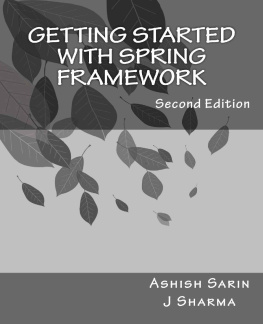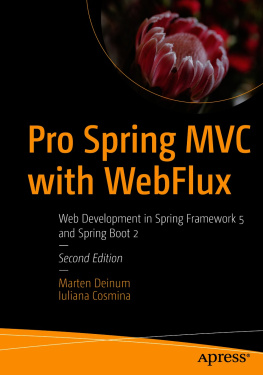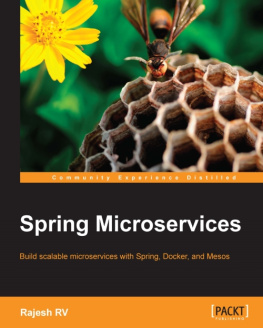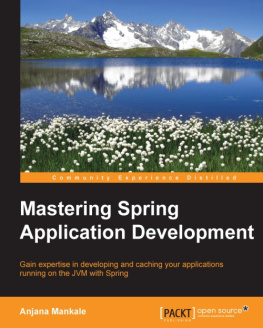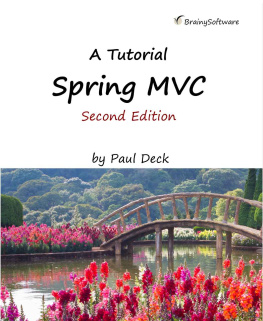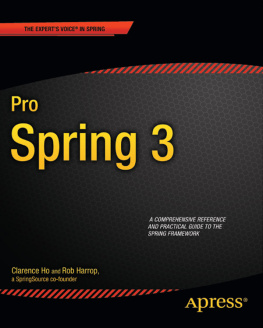J Sharma - Getting started with Spring Framework: a hands-on guide to begin developing applications using Spring Framework
Here you can read online J Sharma - Getting started with Spring Framework: a hands-on guide to begin developing applications using Spring Framework full text of the book (entire story) in english for free. Download pdf and epub, get meaning, cover and reviews about this ebook. year: 2014, publisher: CreateSpace Independent Publishing Platform, genre: Computer. Description of the work, (preface) as well as reviews are available. Best literature library LitArk.com created for fans of good reading and offers a wide selection of genres:
Romance novel
Science fiction
Adventure
Detective
Science
History
Home and family
Prose
Art
Politics
Computer
Non-fiction
Religion
Business
Children
Humor
Choose a favorite category and find really read worthwhile books. Enjoy immersion in the world of imagination, feel the emotions of the characters or learn something new for yourself, make an fascinating discovery.
- Book:Getting started with Spring Framework: a hands-on guide to begin developing applications using Spring Framework
- Author:
- Publisher:CreateSpace Independent Publishing Platform
- Genre:
- Year:2014
- Rating:5 / 5
- Favourites:Add to favourites
- Your mark:
Getting started with Spring Framework: a hands-on guide to begin developing applications using Spring Framework: summary, description and annotation
We offer to read an annotation, description, summary or preface (depends on what the author of the book "Getting started with Spring Framework: a hands-on guide to begin developing applications using Spring Framework" wrote himself). If you haven't found the necessary information about the book — write in the comments, we will try to find it.
PDF version of this book is now available: smashwords.com/books/view/716125
Getting started with Spring Framework is a hands-on guide to begin developing applications using Spring Framework. This book is meant for Java developers with little or no knowledge of Spring Framework. All the examples shown in this book use Spring 4.
You can download the examples (consisting of 60 sample projects) described in this book from the following Google Code project: code.google.com/p/getting-started-with-spring-framework-2edition/
Chapter 1 - Introduction to Spring Framework
Chapter 2 - Spring Framework basics
Chapter 3 - Configuring beans
Chapter 4 - Dependency injection
Chapter 5 - Customizing beans and bean definitions
Chapter 6 - Annotation-driven development with Spring
Chapter 7 - Database interaction using Spring
Chapter 8 - Messaging, emailing, asynchronous method execution, and caching using Spring
Chapter 9 - Aspect-oriented programming
Chapter 10 - Spring Web MVC basics
Chapter 11 - Validation and data binding in Spring Web MVC
Chapter 12 - Developing RESTful web services using Spring Web MVC
Chapter 13 - More Spring Web MVC - internationalization, file upload and asynchronous request processing
Chapter 14 - Securing applications using Spring Security
This book covers:
- Specifying configuration metadata using XML and annotations
- Programmatically configuring Spring container and beans
- Configuring different types of bean properties
- Bean lifecycle interfaces
- Customizing beans using BeanPostProcessors and BeanFactoryPostProcessors
- Bean definition inheritance
- JSR 250s and 330s annotations for dependency injection
- Validation using JSR 303 (Bean Validation API) annotations and Springs Validator interface
- SpEL (Spring Expression Language)
- Caching using Springs cache abstraction
- Sending and receiving JMS messages using Spring
- Aspect-oriented programming support in Spring
- Sending emails using Spring
- Asynchronously executing methods using Spring
- Task scheduling
- Database interaction using JDBC and Hibernate
- Programmatic and declarative transaction management
- Spring Web MVC
- Developing RESTful Web Services using Spring
- Spring Security
The book shows a simple internet banking application that is developed incrementally in each chapter of the book and covers the topics mentioned above.
You can post your feedback and questions to the authors in the following Google Groups forum:groups.google.com/forum/#!forum/getting-started-with-spring-framework
J Sharma: author's other books
Who wrote Getting started with Spring Framework: a hands-on guide to begin developing applications using Spring Framework? Find out the surname, the name of the author of the book and a list of all author's works by series.

